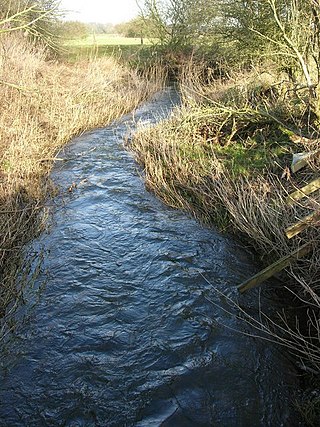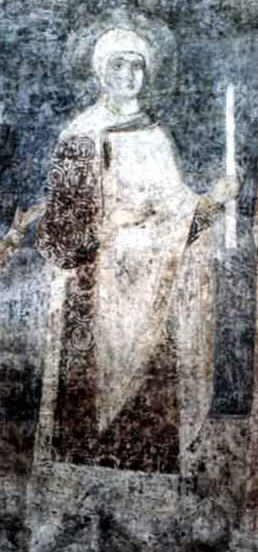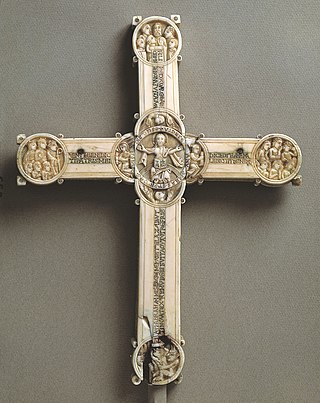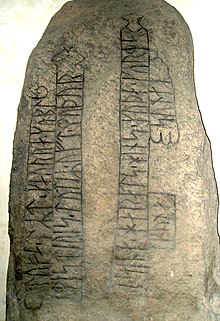
Harald "Bluetooth" Gormsson was a king of Denmark and Norway.

Sweyn Estridsson Ulfsson was King of Denmark from 1047 until his death in 1076. He was the son of Ulf Thorgilsson and Estrid Svendsdatter, and the grandson of Sweyn Forkbeard through his mother's line. He was married at least two times, and fathered 20 children or more out of wedlock, including the five future kings Harald Hen, Canute the Saint, Oluf Hunger, Eric Evergood, and Niels.

A runestone is typically a raised stone with a runic inscription, but the term can also be applied to inscriptions on boulders and on bedrock. The tradition began in the 4th century and lasted into the 12th century, but most of the runestones date from the late Viking Age. Most runestones are located in Scandinavia, but there are also scattered runestones in locations that were visited by Norsemen during the Viking Age. Runestones are often memorials to dead men. Runestones were usually brightly coloured when erected, though this is no longer evident as the colour has worn off. The vast majority of runestones are found in Sweden.

Sigrid the Haughty, also known as Sigrid Storråda (Swedish), is a Scandinavian queen appearing in Norse sagas. Sigrid is named in several late and sometimes contradictory Icelandic sagas composed generations after the events they describe, but there is no reliable historical evidence correlating to her story as they describe her. She is reported by Heimskringla to have been wife of Eric the Victorious of Sweden, sought as wife by Olaf Tryggvasson, then married to Sweyn Forkbeard of Denmark, but elsewhere author Snorri Sturluson says that Sweyn was married to a different woman.
Emund the Old or Edmund was King of Sweden from c. 1050 to c. 1060. His short reign was characterised by disputes with the Archbishopric of Bremen over church policies, and a historically debated delimitation of the Swedish-Danish border.

The River Tove is a river in England, a tributary of the River Great Ouse. Rising in Northamptonshire about a mile north of Greatworth, it flows for about 15 miles (24 km) north and east of the town of Towcester near Bury Mount before meeting the Ouse south-east of Cosgrove just north of Milton Keynes. Its final 5 miles (8 km) form part of the border between Northamptonshire and Buckinghamshire, running alongside the Grand Union Canal. The river ultimately flows into the North Sea.

Thyra was the wife of King Gorm the Old of Denmark, and one of the first queens of Denmark widely believed by scholars to be historical rather than legendary. She is presented in medieval sources as a wise and powerful woman who ordered the building or fortification of the Danevirke, consistent with her commemoration on multiple Viking Age runestones. These include those at Jelling which was the seat of power for her dynasty. When she was born and became queen is unclear, however, she likely ruled until her death in the middle of the 10th century CE.

The Gunderup Runestone, or DR 143, is located in Gunderup, North Jutland County, Jutland, Denmark. It is notable because it is one of few runestones raised in commemoration of a woman.

Sønder Vissing I or DR 55 is a runestone located in the church of Sønder Vissing in eastern Jutland, Denmark. Sønder Vissing is a small settlement located in Horsens municipality approximately 20 kilometres (12 mi) south of Silkeborg, 20 kilometres (12 mi) west of Skanderborg and 40 kilometres (25 mi) northeast of the Viking monuments of Jelling.
Mstivoj was an Obodrite prince from 965 or 967 until his death. He inherited his position along with his brother Mstidrag from their father Nako in an unknown year.

Gunnhildr konungamóðir or Gunnhildr Gormsdóttir, whose name is often Anglicised as Gunnhild, is a quasi-historical figure who appears in the Icelandic Sagas, according to which she was the wife of Eric Bloodaxe. She appears prominently in sagas such as Fagrskinna, Egils saga, Njáls saga, and Heimskringla.

Elisiv of Kiev was a Princess of Kiev and Queen Consort of King Harald III of Norway.
Tovi the Proud, fl. 1018–1043, was a rich and powerful 11th-century Danish thegn who held a number of estates in various parts of southern England. A translation of the legend of Waltham Abbey cites the Lord of Waltham as 'Tovi le Prude', "totius Angliae post regnem primus". He was staller to King Cnut the Great.

The Sønder Kirkeby Runestone, listed as runic inscription DR 220 in the Rundata catalog, is a Viking Age memorial runestone that was discovered in Sønder Kirkeby, which is located about 5 kilometers east of Nykøbing Falster, Denmark.

The Skern Runestone, designated as Danish Runic Inscription 81 or DR 81 in the Rundata catalog, is a Viking Age memorial runestone located in the small village of Skjern, Denmark between Viborg and Randers. The stone features a facial mask and a runic inscription which ends in a curse. A fragment of a second runestone designated as DR 80 was also found in Skjern.

Danish Runic Inscription 48 or DR 48 is the Rundata catalog number for a Viking Age memorial runestone from Hanning, which is about 8 km north of Skjern, Denmark. The runic inscription features a depiction of a hammer, which some have interpreted as a representation of the Norse pagan god Thor, although this interpretation is controversial.

The Ålum Runestones are four Viking Age memorial runestones which are located at the church in Ålum, which is 9 km west of Randers, Denmark. One of the stones refers to a man with the title drengr and two of the other stones were raised by the same family.
Elisabeth (Lis) Jacobsen, née Rubin, was a Danish philologist, archaeologist and writer. She is remembered first and foremost for her research and publications on the history of the Danish language. Among other books, she also published a comprehensive analysis of all known runic inscriptions in Denmark. From 1911, Jacobsen played a major role in all fields of research related to the Danish language.

DR 110, or the Virring stone, is a runestone made of granite that measures 155 cm (61 in) in height, 120 cm (47 in) in width and 27 cm (11 in) in thickness. It is written in Old East Norse in the Younger Futhark, and the runestone style is in a form called RAK.

The Gunhild Cross, named for its first owner, Gunhild, a daughter of Svend III of Denmark, is a mid-12th-century crucifix carved in walrus tusk and with both Latin and Runic inscriptions. It is now in the collection of the National Museum of Denmark.
















